AI at Work
Beyond the Hype: What Top CMOs Are Doing to Unlock AI for Marketing Today

Katie Murphy · Customer Success Manager
April 11th, 2025 · 11 min read

We're constantly meeting with marketing leaders who’re under immense pressure to integrate AI into their strategies while delivering measurable business impact. The companies getting the most value from AI aren't just replacing individual tasks with AI—they're completely transforming their workflows. The conversation around AI has evolved rapidly from "if" to "when" to "how," and your competitors are already incorporating AI into their marketing operations. Proficiency with AI tools is quickly becoming as essential for marketers as Microsoft Office skills were decades ago.
We're excited to share what we're seeing with our customers and provide actionable advice on how you can implement these approaches to exponentially produce personalized content at scale. To watch our full discussion on this topic with the Content Marketing Institute, check out our webinar.

The new enterprise paradigm with AI
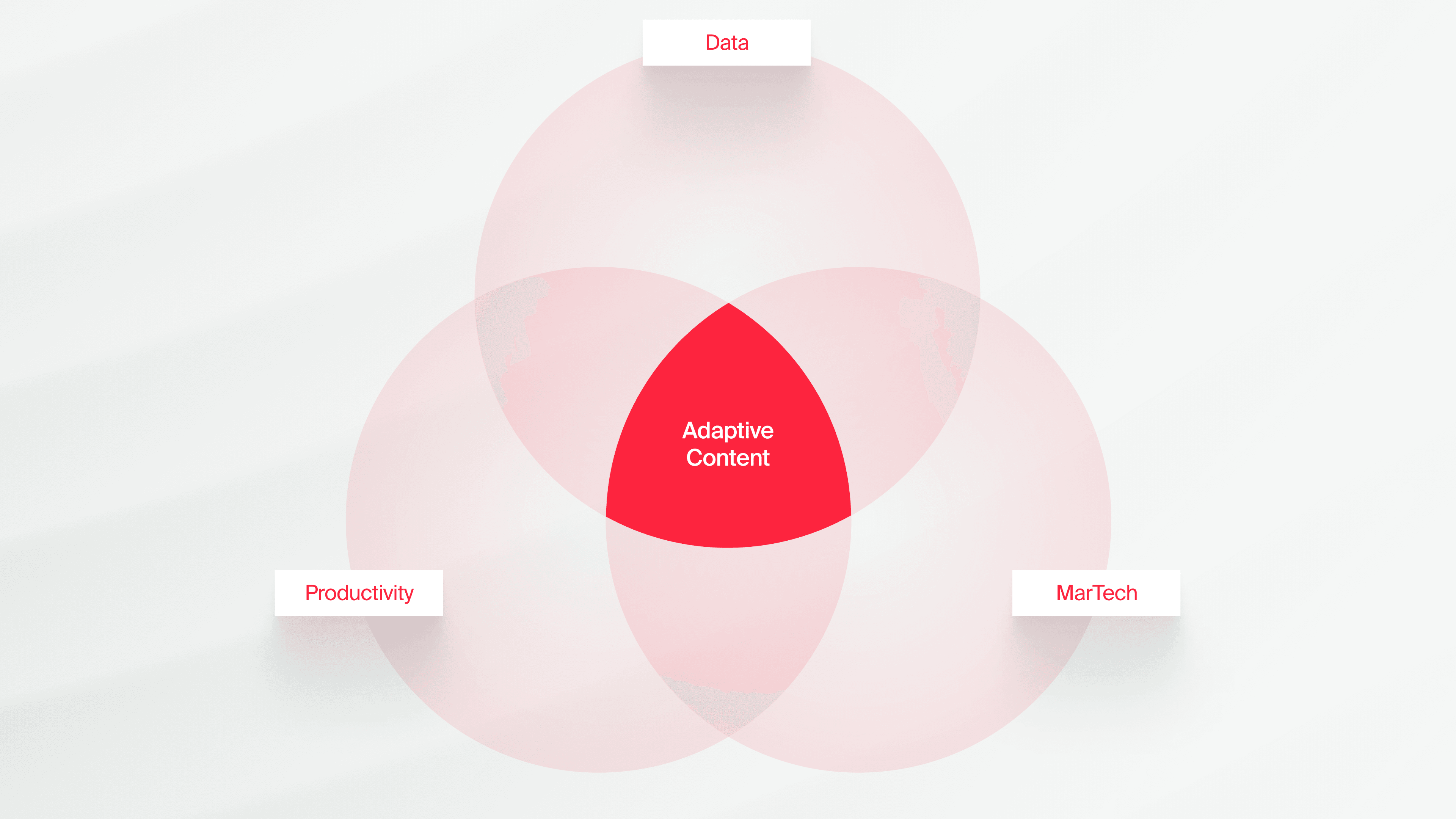
To power personalized content at scale, marketing leaders must rethink how they use AI to connect their data, ecosystem, and workflows. The true opportunity lies at the intersection of three critical elements:
Data: Bring data from CDPs, MarTech platforms, and other applications into a centralized hub to provide a unified view of your customer and brand messaging.
MarTech: Connect your existing technology stack, from email platforms to asset management systems, to ensure content reaches the right audience through the right channels.
Productivity: Integrate AI directly into your team's natural processes to allow for faster and easier adoption.
When these three converge through AI integration, you create what we call Adaptive Content—personalized, brand-consistent materials that can be produced at scale while maintaining quality and relevance. This approach allows marketers to create personalized content with less time and resources and implement multi-channel campaigns faster and at scale.
How to implement AI successfully in marketing: A strategic framework
Our work with marketing organizations has revealed three critical pillars for successful AI implementation. Let's explore how these foundational elements translate into practical steps you can take today.
Establishing your use case: Where to start
The most common stumbling block we see is trying to do too much at once. Pick a lane, start swimming. Where are the most inefficiencies in your business? Where are you falling short? Start by identifying where AI can address specific pain points in your content lifecycle. For example:
Content ideation: Generate email steps to include in a campaign or first drafts of creative briefs. AI can help you get to some of this first draft content or to come up with ideas in significantly less time while allowing teams to explore more creative concepts.
On-brand content creation: Provide your brand details and marketing materials to create a Brand Hub foundation for AI to build upon. This "grounding" approach ensures AI doesn't veer into incorrect or generic territory and helps generate more accurate, relevant, and trustworthy output aligned to your brand requirements.
Content scaling: Explore new content avenues that were previously limited by resources and go beyond A/B testing to include C, D, and E testing for more comprehensive optimization. Instead of focusing on one perfect piece of content, use AI to create multiple variations quickly.
Identifying a clear, high-impact use case provides focused momentum and establishes a foundation for broader implementation. We recommend choosing a use case that delivers visible value within 30-45 days to build organizational confidence.
Building an AI-ready marketing team
The technology is only half the equation. The most critical factor in successful AI implementations is preparing your team for the transition.
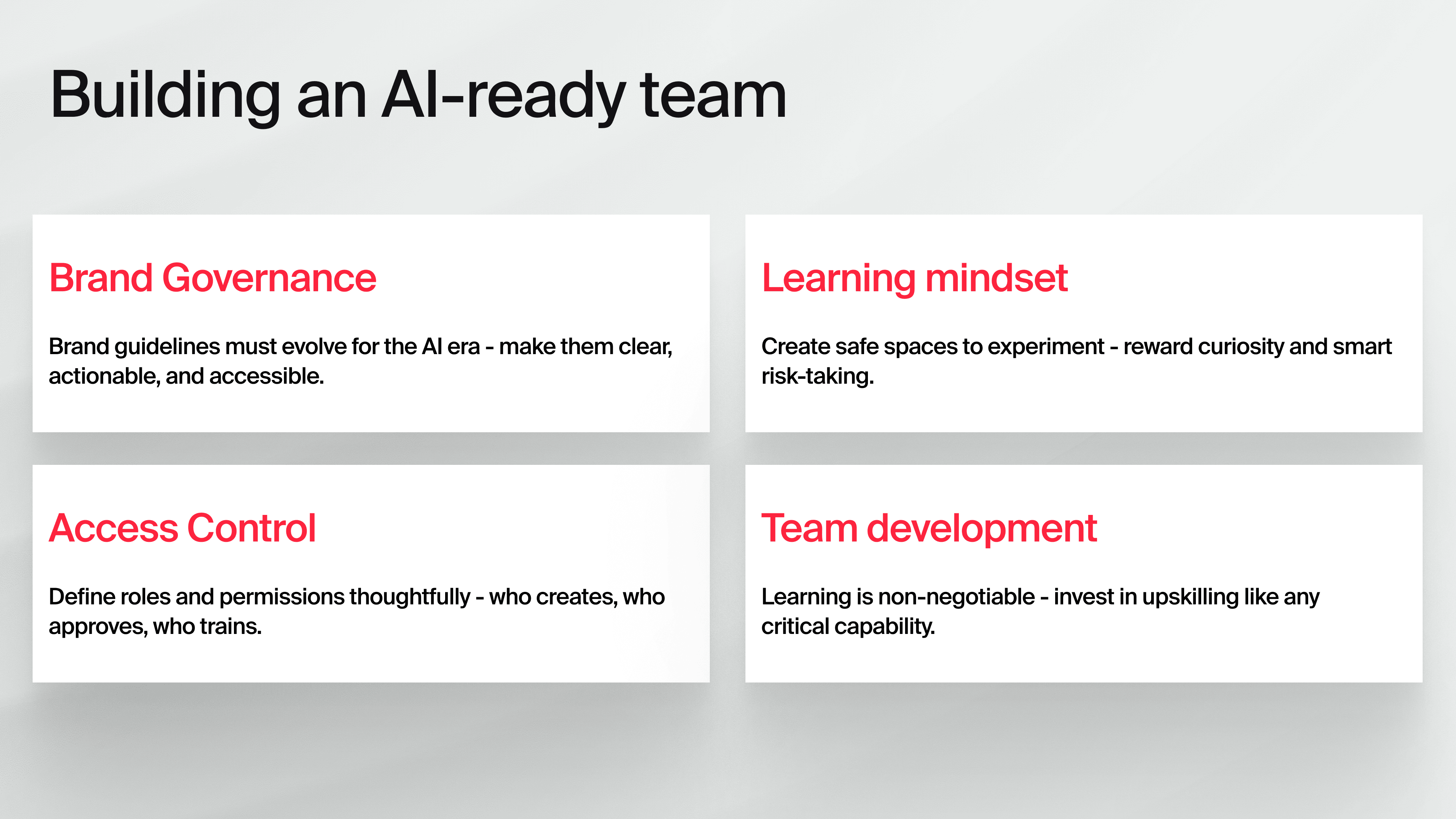
Brand Governance: You have control over maintaining the style and quality of your brand representation on all channels. To ground AI in your brand guidelines, you need to ensure your guidelines are clear and set up within your AI platform. Document how your brand speaks, image style preferences, language rules, design templates, and more in one centralized Brand Hub, so AI can continuously learn and accurately personalize content from it.
Access Control: Define roles and permissions—who creates, who approves, who trains. What I've seen go successfully is starting with a smaller group of power users to lead this calibration phase. These users help refine guidelines before rolling out to larger teams.
Team Development: Invest in upskilling like any critical capability. You really want to encourage and foster a culture of learning and help people feel they�’ll benefit from using these tools rather than feel threatened by them. As one CMO we work with says to her team: "Go wild, learn, play, tell me what course you want to attend"—making AI part of their culture.
Learning Mindset: Create safe spaces to experiment. Celebrate intelligent failures that generate valuable learning, and reward curiosity and problem-solving. The mindset is so key, really coming in with a growth mindset, willing to learn, and a curiosity about how AI can help you.
Generative AI is not an easy button; it requires human guidance. When asked if there's a possibility of not having any human in the loop, I ask back: "Would you ever allow an email to go out without reviewing it first? Would you ever allow paid social content to go out without reviewing it?" The answer is always no. The human-in-the-loop process is extremely important. Treat your AI counterpart as if it is a consultant, agency, or internal content marketing team doing this on your behalf.
Defining and measuring business value
While the technology itself can be exciting, you need to clearly articulate the specific business outcomes you expect and how you'll track value realization:
Enable more ideas, quickly: AI allows your team to come back with more ideas more quickly, supporting a test and learn culture that many companies talk about but struggle to implement due to content constraints. Enable your internal team to come to the table with more ideas and do it faster. AI can also help teams provide agencies with better briefs and direction.
Productivity gains: Get to the final draft of content faster, reducing the time it takes to create high-quality materials. Many of our clients achieve 50-90% productivity improvements within three months of implementation.
Cost efficiencies: Look for pockets of efficiency where your internal team can generate more ideas quickly. Instead of waiting a month for an agency to return two concepts, you can augment their work with six ideas in a week and enable faster brief creation, reducing time and costs.
Extend campaign lifecycles: Give your great content and campaigns more legs and more life by creating variations and adaptations easily.
Create new forms of content: Go multichannel with more personalized, snackable content variations that can reach more audience segments on different channels.
These business outcomes don't happen overnight. Based on our work with marketing teams across industries, we've identified a clear value maturity model that organizations follow as they advance their AI capabilities and realize increasing returns on their investments.
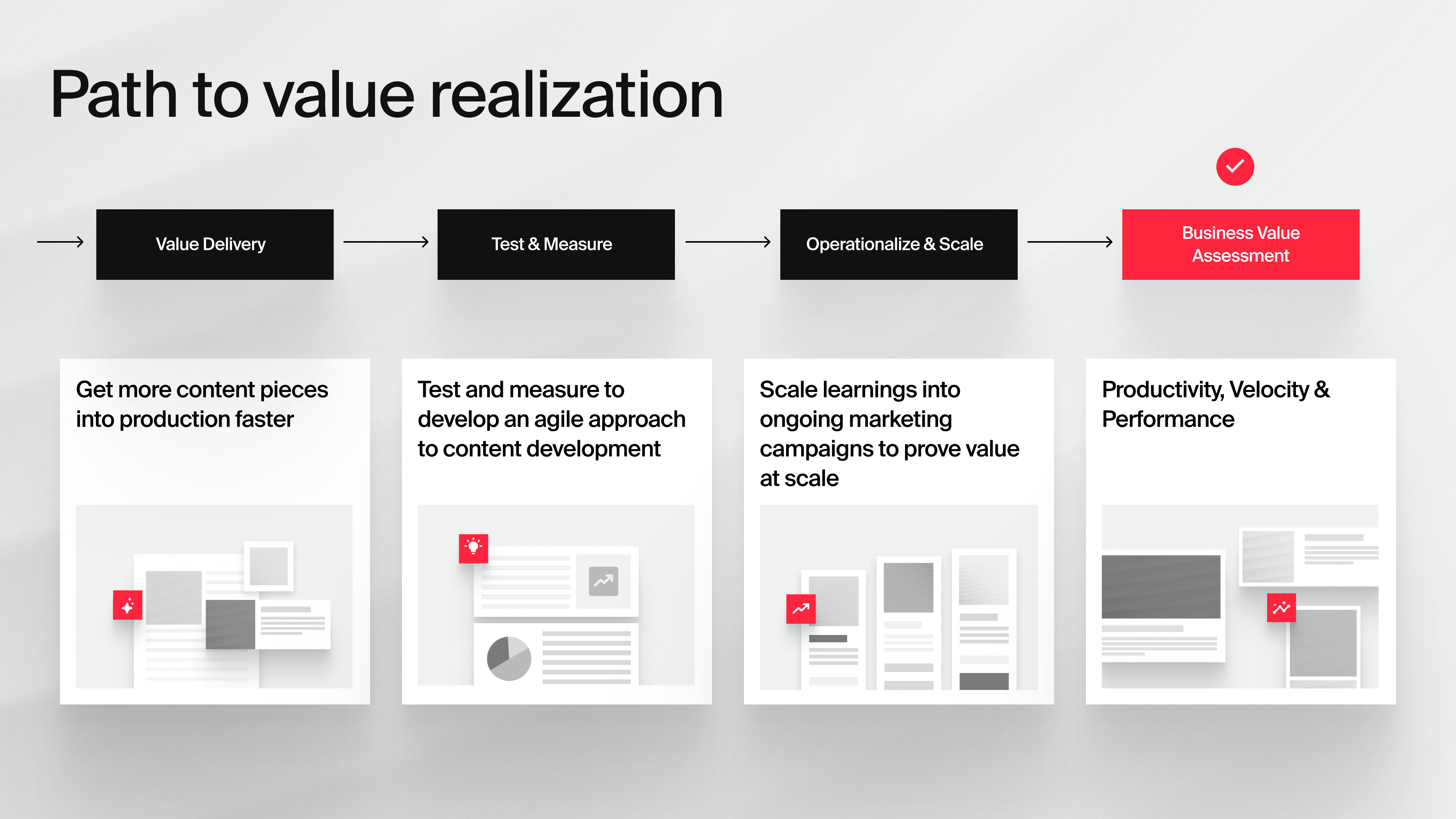
Value delivery: Get more content pieces into production faster
Test & measure: Develop an agile approach to content development
Operationalize & scale: Integrate learnings into ongoing marketing campaigns to prove value at scale
Business value assessment: Evaluate productivity, velocity, and performance improvements
Cultivating an AI mindset: What leaders need to know
Embracing AI requires understanding its strengths and limitations. Here are the key mindset shifts we've observed in successful AI implementations:
Start with 80% and iterate up: Perfection in one shot is unrealistic. You're unlikely to achieve flawless results with generative AI on the first try. Use AI to get 80% there faster and then refine through iteration—these teams move 3x faster than those demanding perfection from the start.
Scale transforms value: The ROI equation changes dramatically at scale. Instead of striving for one perfect piece of content, focus on quickly generating multiple variations, then make a few adjustments to refine them. The value is in generating 20 variations in half the time so you can feed more into your funnel and see what works.
Your brand + AI = ongoing learning relationship: The most successful implementations treat AI like a new team member who needs onboarding to your brand voice and visual identity. AI learns from your brand kit, and you understand AI better by reviewing its output and making necessary adjustments.
New tools demand new workflows: If you try to retrofit AI into your old workflow, you're not using the technology effectively. Many businesses initially ask, "How can this fit into my process?" before realizing they can eliminate unnecessary steps—like cutting out operational handoffs that were taking weeks. You want AI to fit into your current workflows but also figure out what is the most efficient workflow overall.
There's no silver bullet, but there are compound gains: Everyone's always looking for a silver bullet, but it doesn't exist. There is no silver bullet in marketing—just compounded variables, just like with SEO, pipeline generation, or content marketing. The more you use AI, the more comfortable you will be; approach it with a beginner's mindset like learning to ride a bike.
Identifying high-impact AI opportunities
To quickly identify where AI can deliver the greatest value for your marketing organization, map your current pain points to these four key phases:
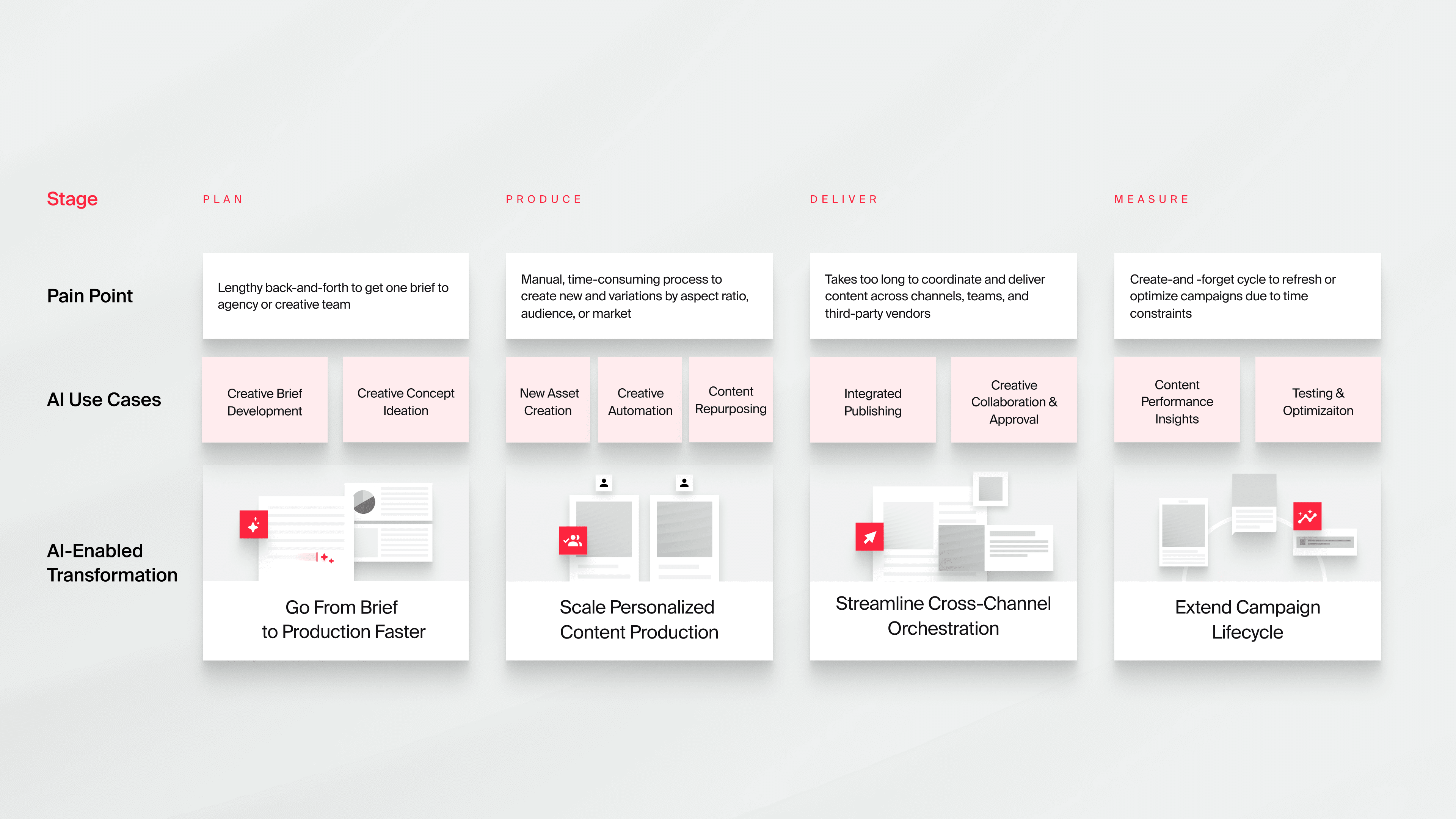
Plan Phase: Reduce lengthy back-and-forth on briefs with AI-powered creative brief development and concept ideation to go from brief to production faster.
Produce Phase: Overcome time-consuming manual creation of variations with new asset creation, creative automation, and content repurposing to scale personalized content production.
Deliver Phase: Streamline coordination across channels through integrated publishing and AI-enhanced collaboration for cross-channel content delivery.
Measure Phase: Break the create-and-forget cycle with content performance insights and testing optimization to extend your campaign lifecycle and improve results.
Getting started: next steps for marketing leaders
As you embark on your AI transformation journey, take these practical steps to ensure success:
Identify your biggest pain points in the content creation process
Start with a clear, focused use case that aligns with business objectives
Assemble a small team of power users to calibrate AI systems before a broader rollout
Make your brand guidelines AI-ready by organizing them in a structured, accessible way
Create a simple value measurement framework to track and communicate success
Budget time for learning, not just technology costs
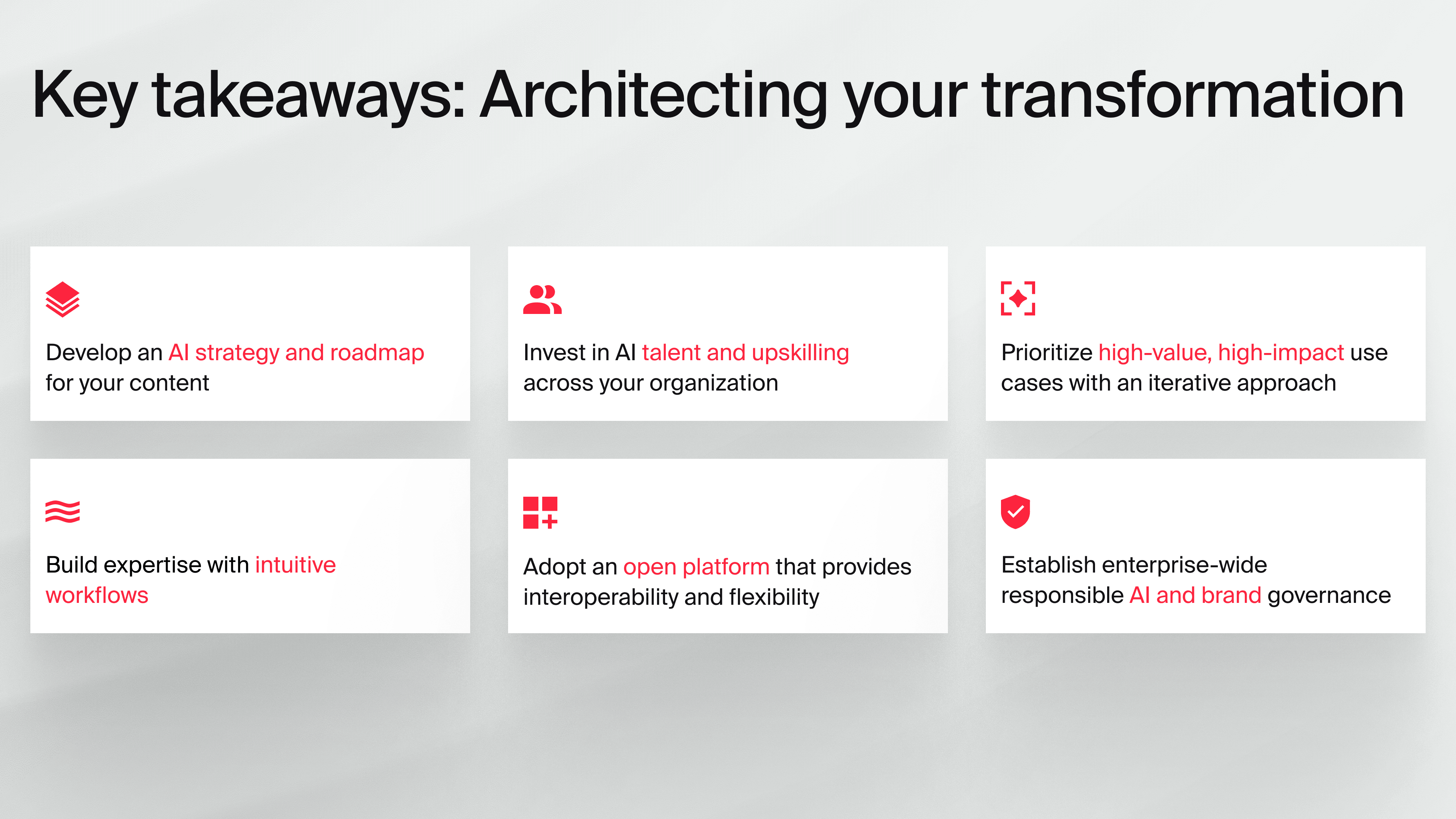
Taking action now
The time is now, and the more time you or your organization waits to adopt this technology, the farther you're going to get left behind. The gap between AI leaders and laggards is widening rapidly. Organizations that have been implementing AI even for just a short time are seeing gains that will be increasingly difficult for latecomers to match.
Proficiency with AI tools is becoming as fundamental for marketing professionals as Microsoft Office skills once were. The organizations gaining competitive advantage aren't necessarily the ones with the largest budgets—they're the ones willing to embrace change and continuous learning.
Ready to transform your marketing operations with AI? Contact us at Typeface or watch our ‘Unlocking AI for Marketing’ webinar to learn how our platform can help you implement these strategies and achieve measurable results in your marketing organization.
About the authors: Alex Mathews helps lead Agency and Consulting Partnerships at Typeface with 17+ years in performance marketing across e-commerce and SaaS companies. Katie Murphy is a Customer Success Manager at Typeface who has worked with marketing professionals at various enterprise companies to build AI into their workflows and manage organizational change.

Share
Related articles
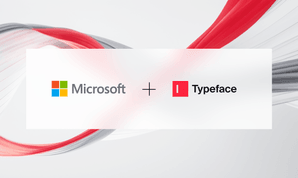
Partnerships
Accelerating Enterprise GenAI Across the Microsoft Ecosystem

Typeface
July 18th, 2023 · 3 min read